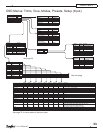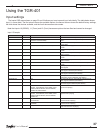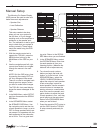
User's Manual
Measurement
microphone
(supplied)
40
CHAPTER 5
The automatic setup procedure
uses the microphone to measure
and evaluate your system. After the
measurements are complete, the
levels, crossover frequency, and delay
times of the speakers in your system
are automatically adjusted for the best
performance. Any problems with the
speakers in your system are indicat-
ed, for example, if there is no output
from a speaker, or if the polarity is
reversed.
Warning: The test procedure can emit
LOUD test tones through your speak-
ers.
The procedure should be done in
a quiet environment, so only the test
tones will be picked up by the mi-
crophone. Use only the microphone
supplied.
Automatic Setup Procedure
SETUP CHOICES
INPUTS
SPEAKERS
VIDEO
MAIN ZONE
ZONE 2
CONTROL
DIGITAL OUT DNMX/THRU
DIMMER LOW/MED/HI
MAIN MENU
TRIMS
TONE CONTROLS
MODES
PRESETS
SETUP
SPEAKERS
AUTO SETUP
SPEAKER SIZE
DISTANCE
LEVEL CALIBRATION
EQ
BINDING POSTS
AUTO SETUP
PLUG MIC INTO FRONT PANEL
JACK AND SELECT “START”
***WARNING***
TEST TONE IS LOUD
START
AUTO SETUP 2
TESTING:
POLARITY
SPEAKER SIZE
DISTANCE
LEVEL CALIBRATION
TEST TAKES 1 MINUTE
CANCEL
AUTO SETUP 3
TEST RESULTS DISPLAYED HERE
ACCEPT
REJECT
1. Place the measurement micro-
phone on the back of your fa-
vorite listening couch or chair.
Try to place it at head height if
possible, in the position where
your head normally is while
listening to your home theater.
The microphone should point
straight up towards the ceiling,
so it has an omni-directional
response for highest accuracy.
2. Connect the microphone to the
Mic input behind the sliding
front panel of the TGR-401.
3. With the remote control set to
operate the TGR-401, press
the MENU button to enter the
OSD main menu. Use the
remote's navigation buttons to
reach the Auto Setup menu.
The testing procedure will start
when you press the right navi-
gation button.
4. When the measurements are
over, the results are displayed,
and you have the option of
rejecting or accepting them.
5. If you accept the results,
the adjustments to the level,
crossover frequency, and delay
are saved and applied to your
system.
• If some of the measurements
are labeled "bad," try moving
the microphone to a new posi-
tion about six inches away, and
repeat the auto setup.
• If the measurements indicate
that a speaker has reversed
polarity, check the speaker
cable connections and cor-
rect this problem. The positive
output of the TGR-401 must
connect to the positive input of
the loudspeaker, and the nega-
tive output must connect to the
negative input of the speaker.
• For larger rooms, or rooms
with multiple seating posi-
tions, it is best to repeat the
measurements several times,
with the microphone in differ-
ent positions within 6 inches
of each other. Write down the
results of each test, and for the
nal test, choose the location
that gives results closest to the
average seen across all loca-
tions. This reduces the chance
of choosing a poor location that
happens to be in a room node.


















